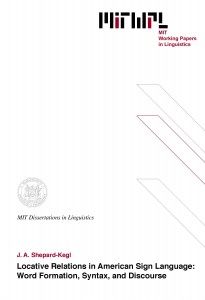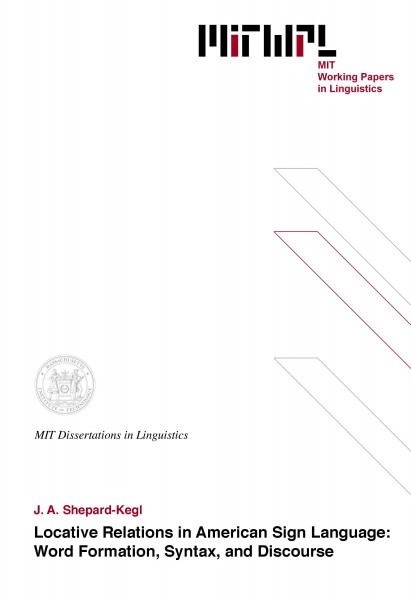Locative Relations in American Sign Language: Word Formation, Syntax, and Discourse
J. A. Shepard-Kegl, 1985
This thesis investigates the role of motino and location in the grammar of American Sign Language and the degree to which motion/location relations lie at the heart of all grammatical systems, particularly those components concerned with thematic relations.
Chapter 1 presents an overview of spatial notions and the role they play in various analyses of spoken language. The claim that languages may exhibit certain sublexical regularities with respect to lexico-semantic primitives such as motion and location forms is distinguished from a theory of lexical decomposition.
Chapter 2 introduces the notational system used in the thesis by examining in detail a series of complex signs which are near minimal pairs with respect to their structural properties and the formatives which comprise them.
Chapter 3 presents a systematic introduction to the ASL lexicon first in schematic terms and later by an examination of the ASL verb system.
Chapter 4 argues for a level ordered, category neutral X-bar account of ASL word formation. Two levels are proposed which differ only on the basis of the position at which their heads occur. Stipulation of head position is shown to eliminate any rule specific statement concerning the ordering of combined elements.
Chapter 5 discusses several issues concerning the role of thematic relations internal to lexical items as well as cases in which thematic positions internal to words appear to be linked with syntactic arguments theta-marked for the same role. A model of word internal theta-role assignment is proposed.
Chapter 6 examines the locative basis of co-reference relations in ASL and the overt co-indexing relationships between discourse NPs, syntactic arguments, case marking clitics and a set of locative agreement markers on the verb. Case relations and theta-roles are shown to be marked by two distinct types of markers which exhibit interestingly different properties with respect to co-indexing relations.
Thesis Supervisors: Noam Chomsky, James Higginbotham, Wayne O"Neil, John Ross
Titles: Institute Professor, Associate Professor of Linguistics and
Philosophy, Professor of Linguistics, Professor of Linguistics
Table of Contents
Chapter 1 Spatial Notinos and Their Role in Language
1.1 Sublexical complexity 13
1.1.1 Lexical decomposition 22
1.1.2 Lexico-semantic primitives 28
1.2 Thematic relations 34
1.3 The locative hypothesis 47
1.3.1 Figurative extension 60
1.3.2 Problems with semantic representations 68
Chapter 2 Introduction to a Locative Based Notational System
2.1 Introduction 77
2.2 Problems with glossing notation 84
2.3 Prose description of a single sign: give 86
2.4 Comparison and contrast of morphologically related signs 103
2.4.1 Move vs. carry-by-hand 106
2.4.2 Give vs. carry-by-hand 107
2.4.3 Carry-by-hand vs. hand-over vs. give 108
2.4.4 Give vs. give-out 109
2.4.5 Inform vs. give-out 111
2.5 A closer look at inform: evidence of compounding 112
2.5.1 An extensional marker for the cognition class: know 113
2.5.2 Evidence from two handed variants of inform 118
2.5.2.1 The symmetry problem 118
2.5.2.2 The body anchoring problem 126
2.5.2.3 The triple agreement problem 128
2.6 Conclusion 135
Chapter 3 An Introduction to the ASL Lexicon
3.1 A schematic introduction to the ASL lexicon 151
3.2 Part I: A schematic introduction to sign structure 152
3.2.1 The simple sign 153
3.2.2 Complex signs 163
3.2.2.1 Singly occurring elements which appear to occur
twice 164
3.2.2.2 Actual doubly occurring elements 171
3.2.2.2.1 Two argument complex words:
(source/goal words) 171
3.2.2.2.2 Negated words 174
3.3 Part II: Introduction to the data -- ASL verbs 183
3.3.1 Simple verbs 183
3.3.1.1 Motion verbs 184
3.3.1.2 Location verbs 190
3.3.1.3 Negated verbs 200
3.3.2 Complex verbs 221
3.3.2.1 Combinations excluded by the thematic coherence
principle 223
3.3.2.2 Exclusion of locatives as members of the set of
complex verbs 226
3.3.2.3 Restriction of complex verbs to combinatin of
FROM and TO 229
3.3.2.4 Distinguishing compound fron complex words 234
3.3.2.4.1 Characteristics of compounds 236
3.3.2.4.1.1 Clitic movement 237
3.3.2.4.1.2 Conditions of the co-
occurrence of clitics with
verbs 239
3.3.2.4.1.3 Stress assignment 246
3.3.2.4.2 Characteristics of complex verbs 247
3.3.2.4.2.1 Complex verbs obey the
thematic coherence principle 248
3.3.2.4.2.2 The salience of paths 252
3.3.2.4.3 Two verb sequences with verb
chaining 253
3.3.3 Summary 258
Chapter 4 Word Formation: Approximations Toward and Analysis
4.1 Root and stem formation 269
4.1.1 An ML-template approach 271
4.1.1.1 Root formation; an ML-template approach 272
4.1.1.2 Stem formation: an ML-template approach 277
4.1.2 A level ordering account 285
4.1.2.1 Base formatino and its consequences 292
4.1.2.2 Two analyses contrasted 293
4.1.2.3 Summary discussion 327
4.1.2.3.1 C-command in lexical
representations 328
4.1.2.3.2 Lexically specified reference to head
position 329
4.2 Two remaining issues 331
4.2.1 The FROM vs. TO distinction 332
4.2.2 The position of the classifier affix 348
4.3 Conclusion 356
Chapter 5 Thematic Relations
5.1 Thematic relations in the lexicon 359
5.1.1 Determination and assignment of word internal theta-roles 360
5.1.1.1 Theta-role assignment 360
5.1.1.2 Sublexical theta-role assignment 363
5.1.2 Word recursion within the theme slot 366
5.1.2.1 Co-occurrence of classifier clitics with embedded
themes 367
5.1.2.2 The lexical integrity of embedded themes 373
5.1.2.3 Idiomatic properties of embedded themes 376
5.2 Thematic relations in the syntax 382
5.2.1 Source/goal vs. subject/object agreement 393
5.2.1.1 The backwards verb illusion 398
5.2.1.2 Non-arguments against a source/goal agreement 401
5.2.1.2.1 The agreement marker omission
argument 403
5.2.1.2.2 The invite argument 407
5.2.1.3 Evidence in favor of source/goal agreement: verb
doubling 409
5.2.2 Causative marking and the construal of agency 424
5.3 Conclusion 453
Chapter 6 Case Marking and Co-reference relations
6.1 Clitics and themes 461
6.1.1 Distinguishing clitics from overt pronouns and anaphors 464
6.1.2 Distinguishing clitics from inflectional affixes 471
6.1.3 The LOCI marker 472
6.2 Typological parameters and empty categories 480
6.3 Conclusion 492

